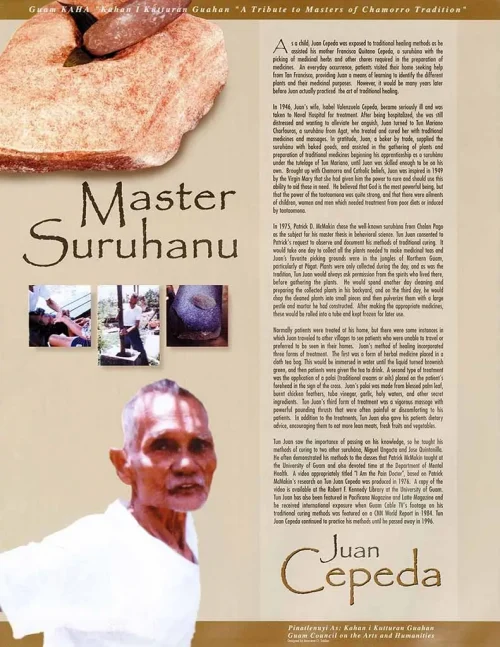Juan Cepeda

Editor’s note: The following entry, with a few additions, was produced by the Guam Council on the Arts and Humanities Agency (CAHA) as part of their publication and poster series, A Journey with the Masters of Chamorro Tradition, 2000.
Master Suruhånu
Juan Cepeda was exposed to traditional healing methods as a child, while he assisted his mother, suruhåna Francisca Quitano Cepeda, with picking medicinal herbs and other chores required in the preparation of medicines. Patients visiting the family home to seek help from Tan Francisca was an everyday occurrence, which provided Juan a means of learning to identify the different plants and their medicinal purposes. However, it would be many years later before Juan actually practiced the art of traditional healing.
In 1946, Juan’s wife, Isabel Valenzuela Cepeda, became seriously ill and was taken to Naval Hospital for treatment. After being hospitalized, she was still distressed. Wanting to alleviate her anguish, Juan turned to Tun Mariano Charfauros, a suruhånu from Hågat, who treated and cured her with traditional medicines and massages. In gratitude, Juan, who was a baker by trade, supplied the suruhånu with baked goods, and assisted in the gathering of plants and preparation of traditional medicines. This was the beginning of his apprenticeship as a suruhånu under the tutelage of Tun Mariano, which carried on until Juan was skilled enough to be on his own. Brought up with CHamoru/Chamorro and Catholic beliefs, Juan was inspired in 1949 by the Virgin Mary, and believed that she had given him the power to cure others. Juan believed that he should use this ability to aid those in need. He believed that God is the most powerful being, but that the power of the taotaomo’na was quite strong, and that there were ailments of children, women, and men which needed treatment from illnesses which were caused by poor diets or induced by taotaomo’na.
In 1975, Patrick D. McMakin chose the well-known suruhånu from Chalan Pago as the subject for his master thesis in behavioral science. Tun Juan consented to Patrick’s request to observe and document his methods of traditional curing. It would take one day to collect all the plants needed to make medicinal teas and Juan’s favorite picking grounds were in the jungles of Northern Guam, particularly at Pågat. Plants were only collected during the day, and as was the tradition, Tun Juan would always ask permission from the spirits who lived there. He would spend another day cleaning and preparing the collected plants in his backyard, and on the third day, he would chop the cleaned plants into small pieces and then pulverize them with a large pestle and mortar that he had constructed. After making the appropriate medicines, these would be rolled into a tube and kept frozen for later use.
Normally patients were treated at his home, but there were some instances in which Juan traveled to other villages to see patients who were unable to travel or preferred to be seen in their homes. Juan’s method of healing incorporated three forms of treatment. The first was a form of herbal medicine placed in a cloth tea bag. This would be immersed in water until the liquid turned brownish green, and then patients were given the tea to drink. A second type of treatment was the application of a palai (traditional creams or oils) placed on the patient’s forehead in the sign of the cross. Juan’s palai was made from blessed palm leaf, burnt chicken feathers, tuba vinegar, garlic, holy waters, and other secret ingredients. Tun Juan’s third form of treatment was a vigorous massage with powerful pounding thrusts that were often painful or discomforting to his patients. In addition to the treatments, Tun Juan also gave his patients dietary advice, encouraging them to eat more lean meats, fresh fruits and vegetables.
Tun Juan saw the importance of passing on his knowledge, so he taught his methods of curing to two other suruhånu, Miguel Ungacta and Jose Quintanilla. He often demonstrated his methods to the classes that Patrick McMakin taught at the University of Guam and also devoted time at the Department of Mental Health. A video appropriately titled “I Am the Pain Doctor”, based on Patrick McMakin’s research on Tun Juan Cepeda was produced in 1976. A copy of the video is available at the Robert F. Kennedy Library at the University of Guam. Tun Juan has also been featured in Pacificana Magazine and Latte Magazine and he received international exposure when Guam Cable TV’s footage on his traditional curing methods was featured on a CNN World Report in 1984. Tun Juan Cepeda continued to practice his methods until he passed away in 1996.
